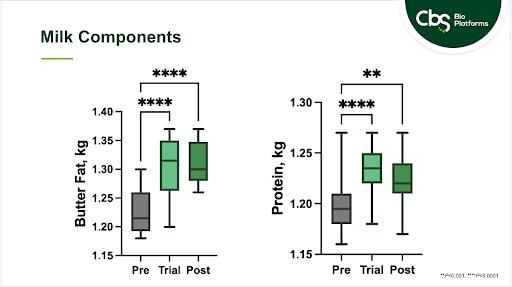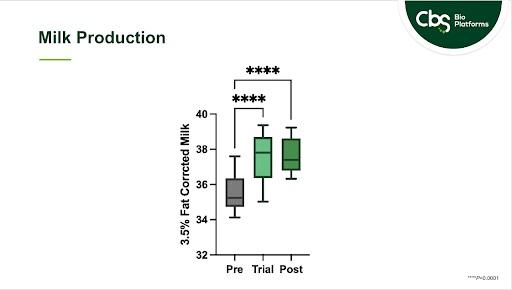New feed tech supports dairy net zero goals, higher milk yields
Published: July 21, 2023
Source : CBS Bio Platforms. July 19, 2023

CBS Bio Platforms feed additive Optimax E shows breakthrough results to help dairy farms optimize efficient sustainable high yielding production
Calgary, ALBERTA – A novel bio-catalyst feed technology shows breakthrough results to help dairy farmers and their industry meet new net zero targets while increasing milk yields.
A recent dairy lactation study with the technology shows significant gains in feed efficiency linked with higher productivity – resulting in a strong return on investment.
“These are very exciting results that come at an opportune time,” says Sabrina Zettell, Nutrition & Technical Service Manager with CBS Bio Platforms, which developed the technology and conducted the trial. “The results show bio-catalyst technology has excellent potential as a tool that dairy farms can rely upon to optimize production efficiency and move toward net zero goals, while actually increasing productivity.”
Promising results boosting efficiency
The study was conducted utilizing a commercial herd of 380 Holstein cows in Mexico averaging 175 days in milk. Animals were on a total mixed ration (TMR) diet primarily of corn silage and alfalfa haylage, comparable to common commercial diets in Canada and the U.S.
Cows were monitored for lactation performance, milk components and dry matter intake. Efficiency and return on investment (ROI) were calculated.
The study utilized pre-trial performance data (from the period leading up to the feeding trial) as control data. For the trial period, for 24 days (175 to 199 DIM) bio-catalyst technology was added to the TMR (20 grams per head per day of Optimax E).
The bio-catalyst treatment was then removed from the diet and performance data was collected for an additional 24-day post-trial period.
Results attributed to bio-catalyst treatment included a number of significant improvements – including to dry matter intake, milk production and efficiency on a fat-corrected milk (FCM) basis. Importantly, these improvements were not only achieved during the treatment period but also carried over during the post-trial period. In fact, milk production and efficiency were not only maintained but continued to improve post-treatment.

Economical with strong ROI
Over 2 litres of additional milk per head per day was achieved during and after supplementation. Researchers calculated this additional production as delivering a significant ROI factoring in the supplement treatment cost.
“Our data shows the use of this bio-catalyst technology in dairy rations can be an economical tool for increased milk production along with improved feed efficiency,” says Zettell. “The greater efficiency achieved improves profitability as well as sustainability.”
The carry over effect observed may be attributed to the impact of the treatment in positively altering the rumen microbial population , she says.
The results suggest that a best strategy for supplementation may be to target transition and fresh cows, recognizing that carry over benefits will be garnered in later lactation even once supplementation is reduced or stopped.
“Supplementation can help the transition and fresh cows peak higher and earlier, while gaining advantages that continue to later stages. The greatest bang for buck will be to supplement at the fresh cow stage and then adjust from there depending on cost and ROI factors.”
Flexible across production approaches
Supplement in the dairy trial was provided as a dry product added to TMR. Based on past research with bio-catalyst technology and this specific supplement, the researchers anticipate results will be similar across dry or liquid application as well as across different feeding and milking systems.
“The supplement is activated once it’s consumed by the animal, with predictable consistent results independent of external factors.”
Results suggest once the supplement is added to TMR it starts activity that builds momentum and has strong longevity, she notes. “Based on what we’ve observed, once the supplement is in the diet farmers can expect to see results within a few weeks, with the best response coming within a month and then continuing forward.”
Further study is underway to expand on the dairy lactation results. Further study is also underway to look at potential ruminant growth performance benefits relevant to beef cattle. “As we’re seeing greater milk production and feed efficiency on the dairy side, we’re hoping to see similar advantages on the meat side as well.”

A ‘win-win’ option for net zero, farm success
Production regions around the world have been considering and adopting new targets for reducing carbon footprint. In Canada and the U.S. this includes the goal to reach net-zero greenhouse gas (GHG) emissions from fam-level dairy production by 2050. In Canada, the Net Zero by 2050 initiative was announced earlier this year by Dairy Farmers of Canada. The U.S. Dairy Net Zero initiative was previously introduced by industry-wide U.S. dairy organizations.
“Anything we can do to improve efficiency is going to help meet these net zero goals,” says Zettell. “Feed supplements that can accomplish this while also increasing returns to dairy farms represent a huge ‘win-win’ for both the present and future of our dairy industries.”
Source
CBS Bio Platforms. July 19, 2023Related topics:
Recommend
Comment
Share

Would you like to discuss another topic? Create a new post to engage with experts in the community.





.jpg&w=3840&q=75)